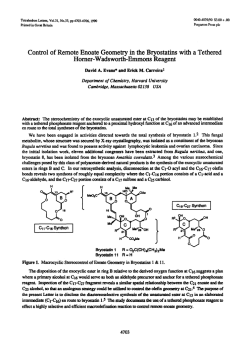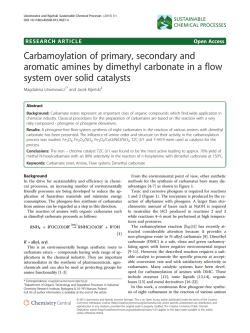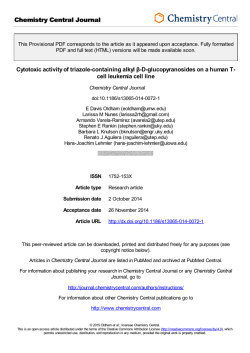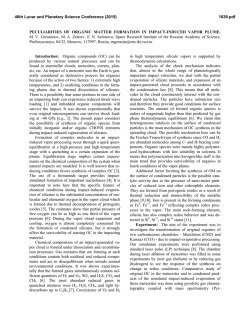
RNHCOOR
‘2,409,712 Patented ‘Oct. 22, ‘1946 UNITED ‘ ' ' PATENT OFFICE , 2,409,712 , CHEMICAL PROCESS AND‘PRODUOTS Carl ‘E. Schweitzer, Newport, DeL, ‘assigno'r to E. I. du Pont de Nemours & Company, Wilming ten, Dial, a corporation of Delaware No Drawing. Application February 3, 1944, Serial No. 520,932 " , ~ 12 Claims. 1' (Cl. 260--453) 2 V This‘ invention relates to isocyanic esters, and particularly to a process for preparing isocyanic esters from readily available starting materials. Hitherto, ‘aliphatic esters‘ of isocyanic, acid were prepared by reaction between aliphatic sul-v fates and’ potassium cyanate. The aryl isocy anates were generally prepared by other proc esses; such as by the reaction of phosgene with aromatic amines, or the reaction of, aryl ure ated, the separation may be e?ected by distilla tion of the pyrolyzate. When the separationis rapid, IL‘G. if ‘the boiling points of the isocyanate and alcohol diiler widely,'reaction ‘between, the isocyanate and alcohol is avoided, or appreciably limited. Even when the boiling points of isocy anate and alcohols are close together, atleast a part of the isocyanate present in the pyrolyzate can generally be separated before recombination thanes with phosphorus pentoxide (Sidgewick’s Organic Chemistrypof Nitrogen, bylTaylor and to form the carbamic ester can occur. for preparing isocyanic esters from N-substituted carbamic esters. Another object is to prepare aliphatic and aromatic esters of isocyanic acid beta-methoxyethyl Ngethyl, carbamate, beta et-hoxy, -beta-ethoxyethyl N-ethyl carbamate, . _ Suitable carbarnic esters which yield separable pyrolysis products according to this invention Baker, Clarendon Press, 1937, pages 3314332) . object of the present invention is to provide include‘beta-methoxyethyl N-methyl carbamate, an improved process for preparing is'ocyanates. ,isopropyl N -methyl carbamate, betaeethoxyethyl A more particular object is to provide a process 15 Isl-methyl carbamate, butyl N-methyl carbamate, from N-substituted carbamic esters without the use of P205 or other such reagents. i These and other objects are accomplished in accordance with this invention‘ by pyrolysis of the N-substituted carbamic ester,‘ followed by isobutyl N-beta-methoxyethyl carbamate, beta-v ‘ niethoxyethyl N-phenyl carbamate, ethoxy 20 ethoxyethyl N-isobutyl carbamate, and the like. Esters of N~phenylcarbamic acids, such as meth yl N-phenyl carbamate and ethyl Nephenyl carbamate may be pyrolyzed to give phenyl iso separation of the isocyanic ester from the pyroly cyanates, which can ‘be separated from the pyrol sis products. This separation, according to this 25 yzate. In the, latter instances the isocyanate boils at a considerably higher temperature than invention, is effected before the pyrolysis prod‘ ~ the alcohol produced by pyrolysis, hence is read ucts have had time to reunite to reform the N' ily separable therefrom by quick distillation. substituted carbamic esters. ‘When the pyrolysis Also, it is possible in accordance with this inven-_ is carefully controlled, as hereinafter described, tion to prepare phenyl isocyanate by pyrolysis of the following reactions occur (“R is an aryl,‘ alkyl, alkoxyalkyl, or alkoxyalkoxyalkyl group; R’ is 30 an N-phenyl carbamic ester of an alcohol which an alkyl, alkoxyalkyl, or alkoxyalkoxyalkyl has a boiling point higher than the normal boil group) : , ‘ , “ ing point of phenyl isocyanate (B. P. 166° 0.). (1) RNI-ICOOR'QRNCO-l-R'OH (2) RNCO+R'OH->RNHCOOR’ This permits distillation of the phenyl isocyanate from the pyrolysis product as a ?rst fraction, which is an advantage since rapid removal of the is'ocyanate is desirable. ‘ i Since Reaction 1 takes place at elevated tempera Certain of the carbamic esters which are‘used tures and Reaction 2 takes place at ordinary in the practice of this invention maybe prepared temperature, the pyrolysis products formed by Reaction lmust be separated'be‘fore the products 40 .by reaction between amines, urea and alcohols, as follows: are consumed by Reaction 2. The N-substituted carbamic esters which may , be‘ pyrolyzed in accordance with this invention include‘ the N-alkyl, N-alkoxyalkyl, N-alk‘oxy— alkoxy'alkyl and N-aryl carbamic esters of the aliphatic alcohols. The esters of N-alkyl car bamic acids, in which the N-alkyl group contains from 1 to 12 carbon atoms, may be usedvery ef fectively. For’ best results, the ester group in such carbamates should correspond to an alcohol In, the above equation R isan aryl, alkyl, alkoxy-j alkyl, or alkoxyalkoxyalkyl group, and R’ repre sents alkyl, alkoxyalkyl or an alkoxyalkoxyalkyl, group. The reaction as written takes place whenthareagents are heated to a temperature in the range 150° C. to 350° 0,,» preferably under superatmospheric pressure. The N-alkyl and N aryl carbamates may also be prepared by reac which preferably is sufficiently high boiling to be to tion between an N,N'-diall~iyl or N;N'-diaryl‘ urea separated readily from the alkyl isocyanate pro and an alcohol, as follows: duced by the pyrolysis. When the alcohol has a. iaurroo'una-patonennricoia'uremia , boiling point which is higher than the boiling point of the isocyariate, withwhich it is associ 55 In this equation‘R is an‘aryl or alkylgroup and 2,409,712 3 4 R’ is an alkyl, alkoxyalkyl or alkoxyalkoxyalkyl group. The reaction as written takes place when put rate in this experiment was limited by the rate of heat input, rather than the rate of re action. A Very slow stream of nitrogen was passed through the tube during the pyrolysis to higher. If the alcohol has a boiling point above 150° C. the reaction proceeds satisfactorily at at (It maintain a positive ?ow. The pyrolyzate was quickly distilled, giving a methanol-methyl iso mospheric pressure, but if the alcohol has a lower cyanate azeotrope which boiled at 36.4°. After boiling point than 150° C., it is preferable to em ploy superatmospheric pressure. Generally the all the methanol in the azeotrope had been al the reactants are heated at about 150° C. or N-alkyl or N-aryl carbamic ester can be distilled lowed to recombine, pure methyl isocyanate, from the reaction product without di?iculty. 10 B. P. 38.9° C., was recovered by distillation. Example 3.—-Urea (0.5 mole) laurylamine The pyrolysis of the N-substituted carbamic (0.15 mole) and ethoxyethoxyethanol (1.0 mole) esters may be conducted either in the liquid or the vapor phase. The pyrolysis temperature was heated for 3 hours at 200° C. Conversion to should be in the range of 135° to 500° C. Prefer ethoxyethoxyethyl N-lauryl carbamate was 57%. ably the pyrolysis pressure should be about at r The resulting mixture was pyrolyzed in the liquid phase at a pressure of about 2 mm. and a tem mospheric or less. It is convenient to pyrolyze perature of 210° to 230° C. Lauryl isocyanate the high boiling N-substituted carbamate in the was separated from ethoxyethoxyethanol in the liquid phase at temperatures above about 250° (3., pyrolyzate by distributing these two pyrolysis at subatmospheric pressures. Undesirable side reactions, such as trimerization of the isocyanate, 20 products between cyclohexane and water. Dis tillation of the cyclohexane layer gave lauryl iso are avoided or appreciably suppressed by operat cyanate (B. P. 106 to 110° at 1 to 2 mm.) in ing at diminished pressure, or in the presence of a carrier gas. The rapid'separation of the isocyanate from the other pyrolysis products is generally accom plished by quick distillation, or by selective con densation, either at atmospheric or subatmos pheric pressure. Various means may be used, according to this invention, to facilitate the sep 75% yield. Example 4.—Beta-isobutoxymethoxy)ethyla mine (0.5 mole), urea (0.5 mole) and ethoxy ethoxyethanol (1.5 moles) were heated for 3 hours at 160° to 240° C.; 95% of the theoretical amount of ammonia was evolved. Excess ethox yethoxyethanol was removed by distillation, and aration so as to avoid recombination of the iso 30 the carbamate (ethoxyethoxyethyl N-beta (iso butoxymethoxy) ethyl carbamate) was pyro cyanate and alcohol. For example, a third com lyzed in the liquid phase at a temperature within ponent may be employed as a diluent during dis the range 200° to 250° C. under subatmospheric tillation. Such third component may form an pressure (20 mm.). The isocyanate (beta-(iso azeotrope with either the alcohol or the isocy butoxymethoxy)ethy1 isocyanate, B. P. 80 to 82° anate, thereby facilitating the removal of the at '7 mm.) was separated from the ethoxyethoxy said alcohol or isocyanate from the pyrolyzate. ethanol by introducing the pyrolyzate into cyclo Alternatively, the pyrolyzate may be collected in hexane-water mixture, and distilling the cyclo a solvent which dissolves either the alcohol or the isocyanate selectively, and the phase containing hexane layer. The overall conversion of isobu— to beta-(isobutoxy the isocyanate may be withdrawn and distilled. 40 toxymethoxyethylamine methoXy)ethyl isocyanate Was 55%. In certain instances the alcohols produced by the Example 5, sym.--Diphenyl urea (0.5 mole) was pyrolysis are azeotropic with the isocyanates processed in boiling ethoxyethanol (1.5 moles) which are simultaneously produced. When this for several hours to yield ethoxyethoxyethyl N occurs, it is desirable to distill the azeotrope, and thereafter to allow the alcohol and isocyanate _ phenyl carbamate, aniline being removed by dis ' tillation. The carbamate was pyrolyzed at a contained therein to recombine, prior to redis tilling the excess isocyanate. temperature of about 200° C. and a pressure of 2 to 5 mm., yielding phenyl isocyanate and ethoxy The pyrolysis of the N-substituted carbamic ethoxyethanol. These products were distributed esters may be conducted in any suitable apparatus between water-cyclohexane mixture, and the cy such as a tubular converter made of quartz, glass, clohexane layer was distilled. A 37% conversion inert metal, or the like. No speci?c catalyst is to phenyl isocyanate, based on the amount of required, but it is helpful to have the converter sym-diphenyl urea initially used, was obtained. packed with a material which serves to promote an The present invention, while illustrated by the even distribution of heat. Such packing mate~ foregoing examples, is not limited thereto, but rials are silver, copper, broken glass, silica, por has general application in the preparation of iso celain and the like. cyanic esters by pyrolysis of carbamates of the This invention is further illustrated by the following examples. formula, RNHCOOR', wherein R is a member of the class consisting of aryl, alkyl, alkoxyalkyl, Example 1.—A mixture containing 2.5 moles of ethoxyethoxyethanol alkoxyalkoxyalkyl groups and R’ is a member of 60 the class of alkyl, alkoxyalkyl and alkoxyalkoxy alkyl groups. The separation of the isocyanic es and 1 mole of N,N’-diisobutyl urea was heated ter from the resulting pyrolyzate may be effected for 2 hours at 200° C. The resulting product in any convenient manner, and the invention is contained 0.75 mole of ethoxyethoxyethyl N _ not restricted to separation methods herein used isobutyl carbamate. This carbamate was pyro 60 as illustrations. It is to be understood that vari lyzed in the liquid phase at 200° C. under 20 mm. ous modi?cations may be practiced without de pressure, and the pyrolyzate was conducted di parting from the spirit and scope of this inven rectly to a stripper column in which the iso tion as de?ned in the appended claims. cyanate was separated from the ethoxyethoxy I claim: ethanol by distillation. Pure isobutyl cyanate 70 1. In a process for preparing alkyl isocyanates (B. P. 106° C.) was obtained in 60.5% yield. the steps which comprise heating an N-alkyl car Example 2.-—Methyl'N-methyl carbamate was bamic alkyl ester to a pyrolysis temperature of passed at the rate of one mole per hour through about7135° to 500° C. and immediately separating a Pyrex tube containing 100 cc. of quartz packing, the resulting alkyl isocyanate from the pyrolysis 8 to 14 mesh, at 430° C. to 440° C. The through 75 products before the said products have had time 2,409,712 5 6 to reunite to form the N-alkyl carbamic alkyl isobutoxymethoxy>ethyl carbamate at a temper ature in the range 200° to 250° C. under ester. . 2. In a process for preparing isocyanic esters the steps which comprise heating to a pyrolysis temperature of about 135° to 500° C. a carbamate of the formula RNI-ICOOR', wherein R. is a mem ber of the class of aryl, alkyl, and allroxyalkoxy alkyl groups, and R’ is a member of the class of subatmospheric pressure, thus producing ethoxy ethoxyethanol and beta- (isobutoxymethoxy) ethyl isocyanate, and immediately separating the said vbeta-(isobutoxymethozqr)ethyl isocyanate from the ethoxyethoxyethanol so produced before the beta-(isobutoxymethoxy)ethyl isocyanate and the ethoXyethoxyethano-l have had time to re alkyl, alkoxyalkyl, and alkoxyallroxyalkyl, and immediately separating an isocyanic ester from 10 unite to form the said ethoxyethoxyethyl beta (N-isobutoxymethoxy) ethyl vcarbamate. the resultant pyrolyzate before the pyrolysis 8. Beta- (isobutoxymethoxy) ethyl isocyanate. products have had time to reunite to form the 9. In a process for preparing lauryl isocyanate said carbamate. the steps which comprise heating ethyoxyethoxy 3. In a process for preparing isocyanic esters the steps which comprise subjecting to pyrolysis 15 ethyl N-lauryl carbamate at a temperature in the range 210° to 230"v C. in the liquid phase at at a temperature in the range of 150° C. to 350° C‘. diminished pressure, and immediately separating a carbamate of the formula RHNCOOR’, wherein lauryl isocyanate from the resultant pyrolysis R, is a member of the class of aryl, alkyl, and al koxyalkoxyalkyl groups, and R,’ is a member of the product su?iciently rapidly so that there is not class of alkyl, and alkoxyalkoxyalkyl, and imme 20 sufficient time for the said laurl isocyanate to be diately separating an isocyanic ester from the reconverted to ethoxyethoxyethyl N-lauryl car resultant pyrolyzate before the pyrolysis prod bamate. 10. In a process for preparing phenyl isocyanate ncts have had time to reunite to form the said the step which comprises heating at a tempera carbamate. 4. The process set forth in claim 3, in which 25 ture in the range 135° to 500° C. an N-phenyl the said carbamate contains an N-alkyl group carbamic ester of an aliphatic alcohol having a having from 1 to 12 carbon atoms. ‘ normal boiling point higher than 166° 0., and immediately separating phenyl isocyanate from 5. In a process for preparing isocyanic esters the steps which comprise heating in the vapor the pyrolysis product sufficiently rapidly so that phase at a temperature in the range of 135° C. 30 the said phenyl isocyanate does not have time to reunite with said aliphatic alcohol produced by to 500° C. a carbamate of the formula RNHCOOR’, wherein R is a member of the class of aryl, alkyl the pyrolysis to form the said N-phenyl carbamic and alkoxyalkoxyalkyl groups, and R’ is a mem ester. ber of the class of alkyl, and alkoxyalkoxyalkyl 11. The process set forth in claim 10, wherein groups, whereby a pyrolyzate containing an alco 35 the said pyrolysis is carried out at a pressure of hol of the formula R’OI-I and an isocyanate of 2 to 5 millimeters. the formula RNCO is obtained, and immediately ' 12. In a process for preparing isocyanic esters the steps which comprise heating in the vapor separating the said alcohol from the said iso cyanate by rapid distillation before the said phase at a temperature in the range of 135° C. alcohol and the said isocyanate have had time 40 to 500° C. a carbamate of the formula RNHCOOR', to reunite to form the said carbamate. wherein R is a member of the class of aryl, alkyl 6. A process for preparing alkyl isocyanates and alkoxyalkoxyalkyl groups, and R’ is a mem which comprises heating an N-alkyl carbamic ber of the class of alkyl, and alkoxyalkoxyalkyl ester of an aliphatic alcohol at a temperature groups, whereby a pyrolyzate containing an all in the range of 135° to 500° C., thereby producing 45 phatic alcohol of the formula R’OH and an iso— a pyrolyzate containing alkyl isocyanate and ali cyanate of the formula RNCO is obtained, ex phatic alcohol, and separating rapidly at least part of the said alkyl isocyanate and aliphatic alcohol before recombination thereof to form N alkyl carbamic ester can occur. 7. A process for'preparing isobutoxymethoxy ethyl isocyanate which comprises heating 'loeta (isobutyoxymethoxy) ethylamine, urea, and ethoxyethanol at a temperature in the range 160° to 204° 0., whereby ethoxyethoxyethyl beta-N (isobutoxymethoxy) ethyl carbamate is-produced, pyrolyzing the said ethoxyethoxyethyl, beta- (N tracting the isocyanate from the said pyrolyzate by means of an alcohol-immiscible solvent, and recovering the isocyanate from the resultant ex 50 tract by distlllation, said extracting of the iso cyanate being performed su?iciently rapidly so ‘ that the isocyanate does not have time to reunite with the said aliphatic alcohol produced by the pyrolysis to form the said carbamate of the for 55 mula RNHCOOR’. / CARL E. SCHWEITZER.
© Copyright 2025



